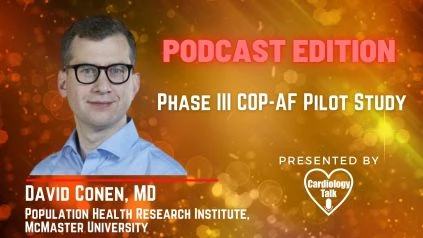Dr. David Conen, MD - Colchicine For Prevention of Perioperative Atrial Fibrillation in Patients Undergoing Thoracic ...
Dr. David Conen is an Associate Professor in the Department of Medicine at McMaster University and a Scientist at the PHRI. He graduated from Harvard University with a Master of Public Health degree after working as an internist and cardiologist in Basel, Switzerland. In this podcast Dr. Conen speaks on Colchicine For Prevention of Perioperative Atrial Fibrillation in Patients Undergoing Thoracic Surgery.
Link to Abstract-
https://clinicaltrials.gov/ct2/show/results/NCT01985425?recrs=e&cond=Heart&phase=23&lupd_s=11%2F01%2F2021&lupd_e=01%2F24%2F2022&draw=2&rank=39
Abstract-
Brief Summary:
The purpose of this pilot study is to determine the feasibility of comparing colchicine to placebo for the prevention of new onset atrial fibrillation in patients undergoing general thoracic surgery and establish the foundation for a large, multi-center, clinical trial.
Primary Outcome Measures :
Clinically Significant Atrial Fibrillation [ Time Frame: Post-operative Day 1 until Postoperative Day 30 ]
New atrial fibrillation that results in angina, congestive heart failure, symptomatic hypotension, or that requires treatment with a rate controlling drug, antiarrhythmic drug, or electrical cardioversion, or that lasts for longer than 30 seconds.
Secondary Outcome Measures :
Death [ Time Frame: Post-operative Day 1 until Postoperative Day 30 ]
New Onset Atrial Flutter [ Time Frame: Post-operative Day 1 until Postoperative Day 30 ]
Replacement of the consistent P waves on 12-lead ECG, or documented telemetry tracing, by saw-tooth flutter waves.
Myocardial Injury After Non-Cardiac Surgery (MINS) [ Time Frame: Post-operative Day 1 until Postoperative Day 30 ]
Requires one of the following criteria:
A) Elevated troponin or CK-MB measurement with one or more of the following defining features:
Ischemic signs or symptoms (i.e., chest, arm, neck, or jaw discomfort; shortness of breath, pulmonary edema);
Development of pathologic Q waves present in any two contiguous leads that are >30 milliseconds;
Electrocardiogram (ECG) changes indicative of ischemia (i.e., ST segment elevation [>2 mm in leads V1, V2, or V3 OR >1 mm in the other leads], ST segment depression [>1 mm], OR symmetric inversion of T waves >1 mm) in at least two contiguous leads;
New LBBB; or v. new or presumed new cardiac wall motion abnormality on echocardiography or new or presumed new fixed defect on radionuclide imaging;
B) Elevated troponin measurement after surgery with no alternative explanation (e.g., pulmonary embolism, sepsis) to myocardial injury
Stroke [ Time Frame: Post-operative Day 1 until Postoperative Day 30 ]
New focal neurological deficit thought to be vascular in origin with signs and symptoms lasting more than 24 hours and cerebral imaging consistent with acute stroke.
Transient Ischemic Attack (TIA) [ Time Frame: Post-operative Day 1 until Postoperative Day 30 ]
New focal neurological deficit thought to be vascular in origin with signs and symptoms lasting less than 24 hours.
Post-operative Infection [ Time Frame: Post-operative Day 1 until Postoperative Day 30 ]



